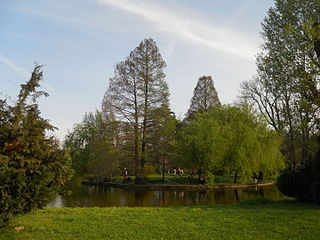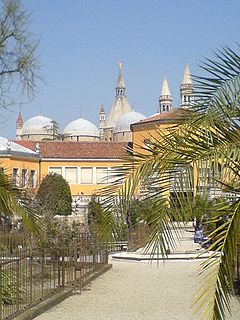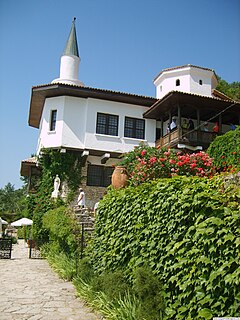
Rhododendron is a very large genus of 1,024 species of woody plants in the heath family (Ericaceae), either evergreen or deciduous, and found mainly in Asia, although it is also widespread throughout lowland and montane forests in the Pacific Northwest, California, the Northeastern United States, and especially in the highlands of the Appalachian Mountains of North America. It is the national flower of Nepal, the state flower of Washington and West Virginia in the United States, the provincial flower of Jiangxi in China and the state tree of Sikkim and Uttarakhand in India. Most species have brightly colored flowers which bloom from late winter through to early summer.

Maria Curie-Skłodowska University (MCSU) was founded October 23, 1944 in Lublin. It is named in honour of Marie Curie-Sklodowska. Currently the number of students is almost 36,000. The university has 302 professors, 231 habilitated doctors, 826 senior lecturers, and 1829 teachers in total. Total staff is 3628. To meet the growing demand for higher education, the university has established branches in other cities.

The Bucharest Botanical Garden, now named after its founder, Dimitrie Brândză, is located in the Cotroceni neighbourhood of Bucharest, Romania. It has a surface of 18.2 hectares, including 4,000 square metres of greenhouses, and has more than 10,000 species of plants.

The University of Copenhagen Botanical Garden, usually referred to simply as Copenhagen Botanical Garden, is a botanical garden located in the centre of Copenhagen, Denmark. It covers an area of 10 hectares and is particularly noted for its extensive complex of historical glasshouses dating from 1874.

The Orto Botanico di Padova is a botanical garden in Padua, in the northeastern part of Italy. Founded in 1545 by the Venetian Republic, it is the world's oldest academic botanical garden that is still in its original location. The garden – affiliated with the University of Padua – currently covers roughly 22,000 square meters, and is known for its special collections and historical design.

The Balchik Palace is a palace in the Bulgarian Black Sea town and resort of Balchik in Southern Dobruja. The official name of the palace was the Quiet Nest Palace. It was constructed between 1926 and 1937, during the Romanian control of the region, for the needs of Queen Marie of Romania. The palace complex consists of a number of residential villas, a smoking hall, a wine cellar, a power station, a monastery, a holy spring, a chapel and many other buildings, as well as most notably a park that is today a state-run botanical garden. Balchik Palace is 17 metres (56 ft) above sea level.

The Orto Botanico di Firenze, also known as the Giardino dei Semplici, the "Garden of simples", is a botanical garden maintained by the University of Florence. It is located at Via Micheli, 3, Florence, Italy, and open weekday mornings.

The Orto Botanico dell'Università di Modena e Reggio Emilia, also known as the Orto Botanico di Modena or formerly Hortus Botanicus Mutinensis, is a botanical garden operated by the University of Modena and Reggio Emilia. It is located next to the Garden Ducale, at viale Caduti in Guerra 127, Modena, Italy, and open weekdays during the warmer months except August. Admission is free.
The Orto Botanico dell'Università di Trieste is a nature preserve and botanical garden operated by the University of Trieste, Friuli-Venezia Giulia, northern Italy.

The Orto Botanico dell'Università di Catania, also known as the Hortus Botanicus Catinensis, is a botanical garden in Catania, Sicily, southern Italy. It is operated by the University of Catania botany department. This institution is a member of BGCI, with international identification code CAT.

The Orto Botanico dell'Università di Siena is a botanical garden operated by the University of Siena. It is located at Via P. A. Mattioli, 4, Siena, Tuscany, Italy, and open daily.

The Orto Botanico del Monte Baldo, also known as the Orto Botanico di Novezzina or Orto Botanico d'Europa, is a botanical garden located at 1232 meters altitude on Monte Baldo, Via General Graziani 10, Novezzina, Ferrara di Monte Baldo, Province of Verona, Veneto, Italy. It is open daily in the warmer months; an admission fee is charged.

The Jardin botanique des Cordeliers is a botanical garden located at the Place des Cordeliers, Digne-les-Bains, Alpes-de-Haute-Provence, Provence-Alpes-Côte d'Azur, France. It is open weekdays in the warmer months; admission is free.

Leipzig Botanical Garden, , is a botanical garden maintained by the University of Leipzig, and located at Linnéstraße 1, Leipzig, Saxony, Germany. It is the oldest botanical garden in Germany and among the oldest in the world, and open daily without charge.

The Iași Botanical Garden, now named after its founder, Anastasie Fătu, is a botanical garden located in the Copou neighbourhood of Iași, Romania. Established in the year 1856 and maintained by the Alexandru Ioan Cuza University, it is the oldest and largest botanical garden in Romania.

The Jardin botanique de la Faculté de Pharmacie, more formally the Jardin de la Faculté des Sciences Pharmaceutiques et Biologiques de l'Université de Lille 2, is a botanical garden and arboretum operated by the Faculty of Pharmacy of the Université de Lille 2. It is located at 3 Rue du Professeur Laguesse, Lille, Nord, Nord-Pas-de-Calais, France, and open weekdays except university holidays; an admission fee is charged.

Adenanthos macropodianus, commonly known as gland flower, or Kangaroo Island gland flower, is a species of shrub in the family Proteaceae. It is endemic to Kangaroo Island in South Australia. First published as a variety of A. sericeus in 1870, it was promoted to species rank in 1978.

The Yerevan Botanical Garden of the Armenian National Academy of Sciences, is the body responsible for plant collections in Armenia. It is located in the Avan district at the north-eastern part of the capital Yerevan, occupying around 80 hectares of a semi-deserted area. The collection includes more than 200 species of endemic, rare and declining plants, and provides a basis, in a relatively natural environment, for the study of the Armenian flora and the ecological interactions between plant species.

The taxonomy of Narcissus is complex, and still not fully resolved. Known to the ancients, the genus name appears in Graeco-Roman literature, although their interest was as much medicinal as botanical. It is unclear which species the ancients were familiar with. Although frequently mentioned in Mediaeval and Renaissance texts it was not formally described till the work of Linnaeus in 1753. By 1789 it had been grouped into a family (Narcissi) but shortly thereafter this was renamed Amaryllideae, from which comes the modern placement within Amaryllidaceae, although for a while it was considered part of Liliaceae.


















